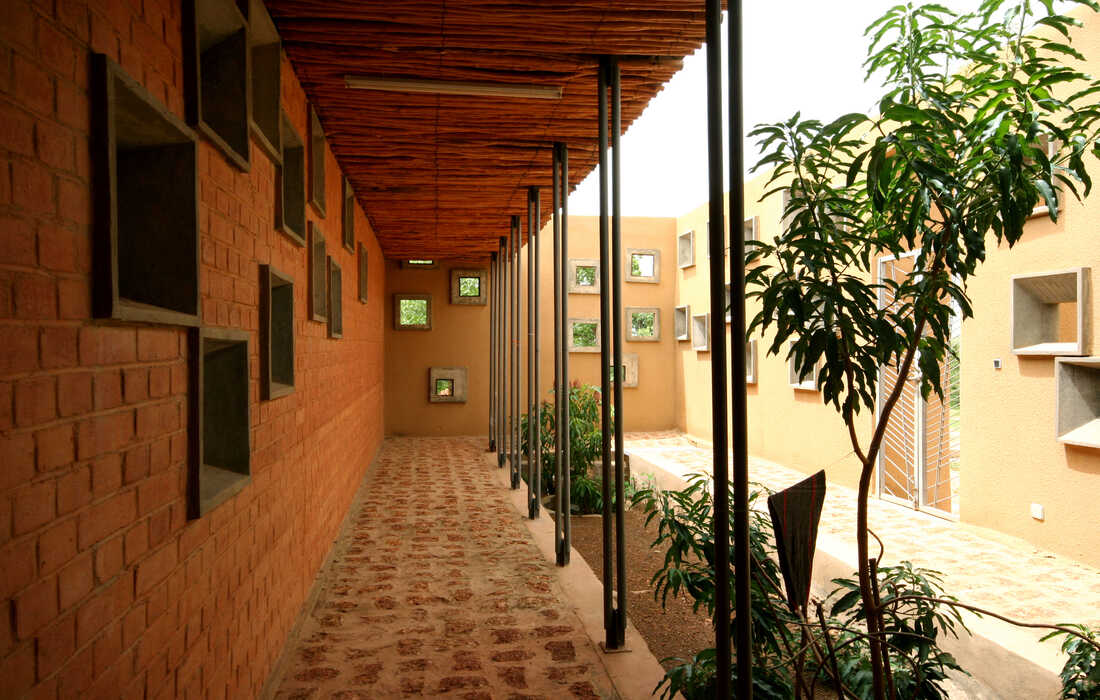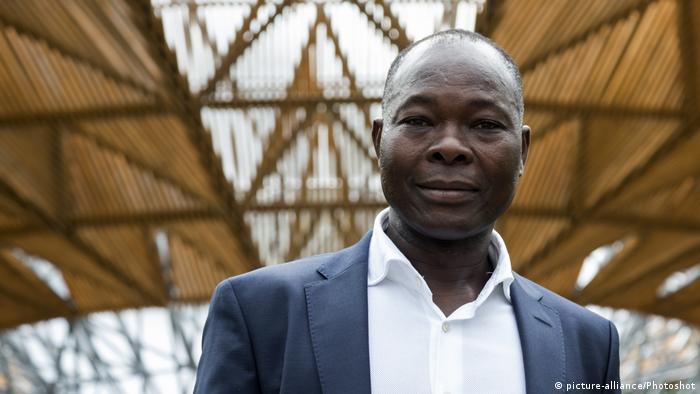Diébédo Francis Kéré appears on a Zoom screen in a loose white Oxford shirt and an enormous, slightly flabbergasted smile.
"Can you imagine?" the newest Pritzker Architecture Prize laureate exclaims. "I was born in Burkina Faso, in this little village where there was no school. And my father wanted me to learn how to read and write very simply because then I could then translate or read him his letters."
Kéré spoke to NPR from Porto-Novo, the capital of Benin, where Kéré Architecture is currently working a new parliamentary building inspired by the palaver tree. It is, he says, a West African symbol of consensus building, and he hopes the building will reflect a commitment both to tradition and democratic process. "Literally speaking, it is a tree under which people come together to make decisions, to celebrate," Kéré explains. "You know, you get to think together and everyone can be part of the debate or the discussion."
The first Black winner of the Pritzker Architecture Prize had already received numerous accolades in his field, including the Aga Khan Award and the Thomas Jefferson medal, but Kéré was as surprised as anyone else to be selected for the field's most famous prize. Many architects and critics had openly supposed that 2022 would be Sir David Adjaye's year. The most prominent Black "starchitect" is best known for designing such notable buildings as the Nobel Peace Center in Oslo, Norway, and the National Museum of African American History and Culture in Washington, D.C. Kéré, who is based in Berlin but centers much of his practice in Africa, has been – until now — far lesser known, with signature buildings that include primary schools and a health care clinic.

Jaime Herraiz Martinez/The Pritzker Architecture Prize
"Francis Kéré is pioneering architecture — sustainable to the earth and its inhabitants — in lands of extreme scarcity," said committee chair, Tom Pritzker, in a statement. "He is equally architect and servant, improving upon the lives and experiences of countless citizens in a region of the world that is at times forgotten. Through buildings that demonstrate beauty, modesty, boldness and invention, and by the integrity of his architecture and geste, Kéré gracefully upholds the mission of this Prize."

Jaime Herraiz/The Pritzker Architecture Prize
Kéré says his architectural practice was inspired by his own experience attending school with around 100 other children in a region where temperatures regularly exceed 100 degrees Fahrenheit. "You will sit and it's very hot inside," he told NPR. "And there was no light, while outside, the sunlight was abundant and in my head, I think, the idea one day grew [that] as an adult, I should make it better. I was thinking about space, about room, about how I can feel better."

The Pritzker Architecture Prize
In his designs for Gando Primary School and Naaba Belem Goumma Secondary School in Burkina Faso, Kéré drew on traditi
onal building materials such as local clay mixed with concrete, and emphasized shade and shadows with well-ventilated spaces that reduce the need for air conditioning. He wanted the buildings to evoke the sense of an oasis. "I am creating a huge canopy for many, many children, to be happy and learn how to read and write," he says.

The Pritzker Architecture Prize
When he was twenty, in 1985, Kéré earned a vocational scholarship to study carpentry in Berlin. But while immersed in the practicality of roofing and furniture making, he also attended night school and was admitted to Technische Universität Berlin, from which he graduated in 2004 with an advanced degree in architecture. He was still a student when he designed and built the innovative Gando Primary School. The recognition it earned helped Kéré establish his own practice in Berlin.

Iwan Baan/The Pritzker Architecture Prize
"He knows, from within, that architecture is not about the object but the objective; not the product, but the process," says the 2022 Jury Citation, in part. "Francis Kéré's entire body of work shows us the power of materiality rooted in place. His buildings, for and with communities, are directly of those communities – in their making, their materials, their programs and their unique characters."
Latest Stories
-
I didn’t speak against holding wrongdoers accountable – Rev. Kwadwo Bempah clarifies ORAL comment
33 minutes -
RSS Developers to hold 3-day open house event on home purchasing from Friday, Dec. 27
53 minutes -
Elikem Treveh: How TEIN UMaT students contributed significantly to NDC’s victory in Tarkwa Nsuaem constituency
1 hour -
Joy FM Family Party in the Park kicks off with excitement at Aburi Botanical Gardens
1 hour -
JP U-15 Cup 2024: Fadama Ajax wins maiden edition
2 hours -
Lured for Love, Caged for Cash: How an 80-year-old American seeking love was kidnapped in Ghana by a Nigerian gang
2 hours -
Star Oil Ltd @ 25: Driving Growth and Profitability with a Vision for Renewable Energy and a Sustainable Future
3 hours -
American Airlines resumes flights after technical issue
4 hours -
NDC Greater Accra Chairman dismisses unauthorised appointment nomination request
4 hours -
Man City might miss out on Champions League – Guardiola
5 hours -
Joy FM’s Party in the Park set to thrill at Aburi Botanical Gardens today
5 hours -
KiDi performs with childhood idol, Kojo Antwi at ‘Likor On The Beach’
5 hours -
South Korea MPs file motion to impeach acting president
6 hours -
Star Oil Ltd @ 25: Driving growth and profitability with a vision for renewable energy and a sustainable future
6 hours -
Bald eagle officially declared US national bird after 250 years
6 hours

